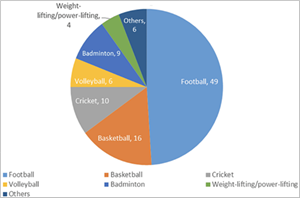Ajman's Youth in Sport: Unraveling Injury Trends and Factors
Main Article Content
Abstract
Objective: The objective of this study was to determine the prevalence of sports-related injuries among athletes in Ajman, UAE, and to determine possible risk factors associated with these sports injuries. Methods: This study adopted a cross-sectional study format in which we surveyed 100 athletes attending a medical university in Ajman, UAE. The subjects of this study were all over the age of 18 and reported practicing the sport or exercise more than twice a week, consistently. An interviewer-administered questionnaire was administered, which inquired about the subjects' socio-demographic characteristics, details of sports activity, type of injury, and factors associated with a sports-related injury. The results were expressed in frequencies and percentages, wherever applicable. The association between dependent and independent variables was tested by performing a chi-square test as well as binary logistic regression for significant chi-square values. This study’s significance level was set at p ≤ 0.05. Results: Among the participants engaged in football, 20 (44.4%) were identified as having sustained injuries, marking football as the sport with the highest incidence of sports-related injuries. Cricket and weight-lifting emerged as the most injury-prone sports, with 60% (6 & 3, respectively) of participants in these activities reporting injuries. The most frequently self-reported type of injury was sprains, accounting for 47.8% (33 respondents), followed by bruises at 33.33% (23 respondents). Among the participants, 59.2% (N = 58) reported experiencing no sports-related injuries, while 40.8% (N = 40) did encounter a sports injury in the last 12 months. When examining the specific injury sites, the lower limb was the most common, with 51% of participants experiencing injuries in this area (N = 20). The upper limb followed closely, where 35% of participants reported injuries (N = 14). A smaller proportion experienced injuries in the head (7%, N = 3), chest (4%, N = 2), and groin (3%, N = 1). Gender was identified as the sole significant risk factor (P = 0.02), as revealed by simple binary logistic regression analysis. The findings indicated that male respondents were 2.9 times more likely to sustain sports-related injuries than their female counterparts (95% CI: 1.1- 7.2). Conclusions: Within the last 12 months, 40.8% (N=40) of participants were identified as having experienced an injury, and approximately 70.4% (N=69) reported a history of sports-related injuries. Our investigation underscores that organized sports activities are primarily associated with injuries to the lower limbs, specifically the legs, with 51% (N=20) of participants attributing their injuries to this region. This correlation is likely influenced by the prevalence of football (soccer) participation, which demands extensive use of the lower limbs. The most commonly reported injury was a sprain, noted by 47.8% (N=47) of participants. Notably, the only factor exhibiting a statistically significant association with injury prevalence was gender.
Article Details

This work is licensed under a Creative Commons Attribution 4.0 International License.
